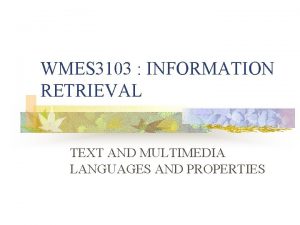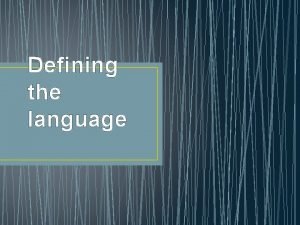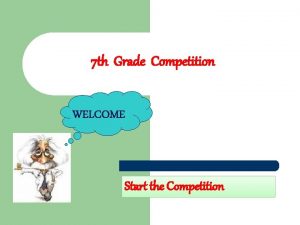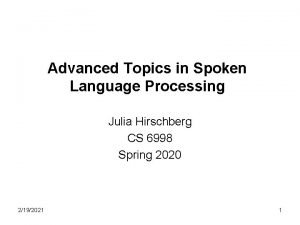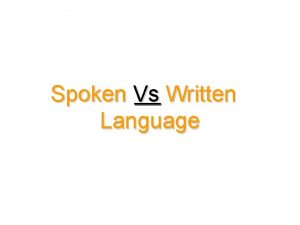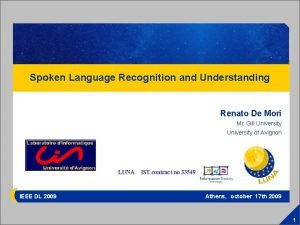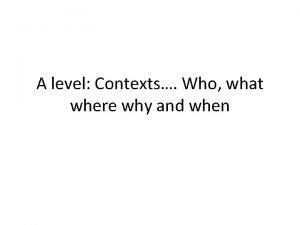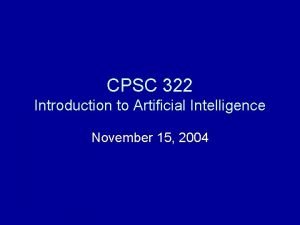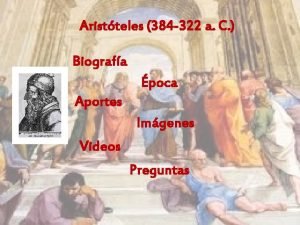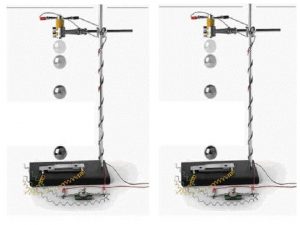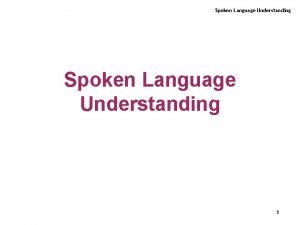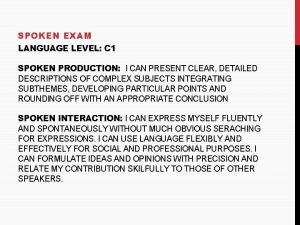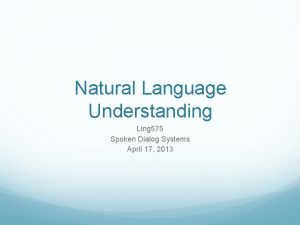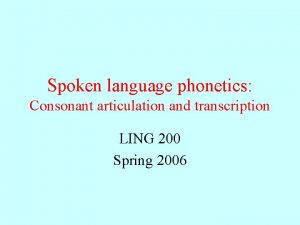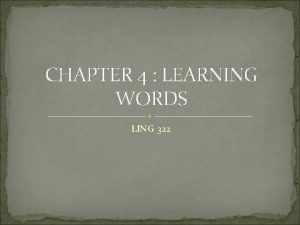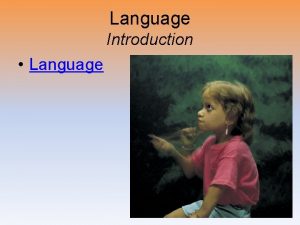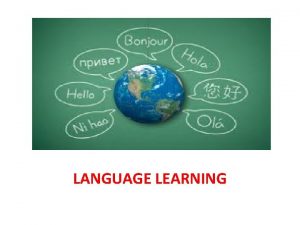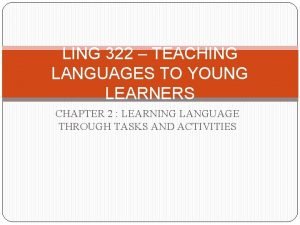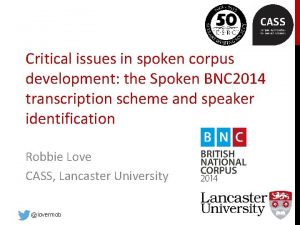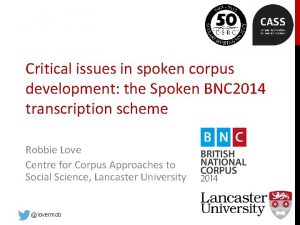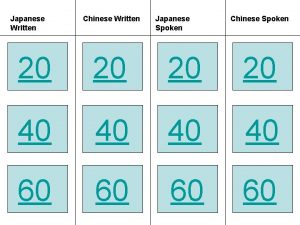LING 322 CHAPTER 3 LEARNING THE SPOKEN LANGUAGE





















- Slides: 21

LING 322 CHAPTER 3 : LEARNING THE SPOKEN LANGUAGE

GUIDING PRINCIPLES MEANING MUST COME FIRST PARTICIPATION IN DISCOURSE AND BUILD UP KNOWLEDGE AND SKILLS FOR PARTICIPATION

OVERVIEW WHY LEARN LANGUAGE FROM AN EARLY AGE? WHICH IS HARDER – LISTENING OR SPEAKING, FOR A CHILD? DESCRIPTION OF DISCOURSE DIFFERENT TYPES OF DISCOURSE IS PERSONAL MEANING IMPORTANT IN LEARNING LANGUAGE?

DISCOURSE – WHAT IS IT? ü Contrasted with text – concerns use of language Contrast of sentence – language longer than a sentence Children able to use language in real life!!!

CHILDREN AND MEANING Desire to connect with others Language as the primary tool Have only partial understanding Use social knowledge to understand new language

SPEAKING AND LISTENING RECEPTIVE AND PRODUCTIVE? INPUT AN OUTPUT?

TASK IN ACTION Changing/modifying the plan Teacher-learner interaction Personal meaning is key

FORMULAIC LANGUAGE Formulaic sequences Phrases broken down and combined Formulaic phrases help discourse development

CONVERSATIONAL INTERACTION EXTENDED TALK

DEVELOPMENT OF CONVERSATIONAL SKILLS At 4 -11 years Discourse in classrooms Training in communication

DEVELOPING CHILDREN’S DISCOURSE REPERTOIRES NARRATIVES DESCRIPTIONS INSTRUCTIONS ARGUMENTS OPINIONS

NARRATIVES ü ü ü Not just a discourse but a mode of mental organisation Key features include : Organisation of events Intentional actions of participants Cause and effect Resolution of problems Thematic structure as well temporal structure

LANGUAGE OF NARRATIVE Constructing cohesive narrative requires use of relative clauses, connectives, pronominal reference, adverbs, and verb tense Children are able to use time words and phrases much earlier than understanding them Contextual information facilitate comprehension of phrase meaning Continuous exposure and uses help meaning become comprehensible to children Eg: the reality of concepts and days will become comprehensible when a child reaches 8 or 9 years of age

DESCRIPTION Paradigmatic mental organization – categorising the world, naming objects and characteristics Found in early childhood social interaction (colours or name animals) Can lead to formal, abstract concepts, logical arguments Development can be traced through precision in use of language resources, and complexity of resources

DESCRIPTION Eg : Appearance : feathers Structure : wings, beak, feet, head Habits : flies, nest Food : fruit Pet habitat : cage, bell, mirror, perch To describe : children need to access prior knowledge and language to describe them

THEORETICAL ASSUMPTIONS Children as discourse participants search meaning and coherence Discourse has different demands Children need to participate in discourse Children need to build up knowledge and skills for participation Children need to learn the parts of a description and practise integrating them

WHAT CAN TEACHERS DO SUPPORT BY MAKING MEANING ACCESSIBLE MAKE CHILDREN AWARE OF THE TYPES OF DISCOURSE UNDERSTAND CHILDREN’S DEVELOPING COMMUNICATION SKILLS AND COGNITIVE ABILITIES UNDERSTAND THE IMPORTANCE OF WORKING OUTWARDS FROM THE FAMILIAR UNDERSTAND THE PRIMACY OF NARRATIVES UNDERSTAND THE EDUCATIONAL

SUPPORT FOR CHILDREN FOREIGN LANGUAGE DISCOURSE SKILLS 1. Motivating topics – they must have something they want to say 2. Task structure - goal or purpose, what is going to happen at the different stages 3. Language practice – word, phrase or clause level, models of language use, practice, opportunities

SUGGESTED ACTIVITIES LISTENING AND DOING LISTENING AND SAYING SOUNDS IN DISCOURSE • Listen and identify • Bingo • Listen and take away • Find the odd one out • Listen and put • Look and say • Listen and choose • Listen and sort • Tennis game • Guess my animal – questions • Guess my animal - actions • Poems or chants • Tongue twisters

SPOKEN LANGUAGE AND WRITTEN LANGUAGE Children find it easier to learn new language through listening and speaking compared to writing Determine the needs of written English in classroom activities in line with language learning goals Listening may provide models for discourse, and may prepare for reading and writing

IN SUMMARY • • • Language is a tool for social interaction Children use language to understand how people operate socially and mentally Speaking demands more of the child, needs support for understanding and production Meaning must come first to enable the child to complete a task Up to age 11, children may not ask questions when they don’t understand Goal to language learning is to use it in real life
 Multimedia information retrieval in irs
Multimedia information retrieval in irs What language is spoken in vietnam
What language is spoken in vietnam Back chanelling
Back chanelling Spoken language features
Spoken language features Most spoken language in the world
Most spoken language in the world Macrolinguistics definition
Macrolinguistics definition Most spoken language in the world
Most spoken language in the world Adv spoken language processing
Adv spoken language processing Characteristics of spoken and written language
Characteristics of spoken and written language Renato de mori
Renato de mori Why was french the language spoken in valmonde
Why was french the language spoken in valmonde Ankara university
Ankara university Me 322
Me 322 Sp_replincrementlsn
Sp_replincrementlsn Mycin
Mycin Biografia de aristóteles (384-322 a.c.)
Biografia de aristóteles (384-322 a.c.) De que trata el decreto 3222 de 2002
De que trata el decreto 3222 de 2002 Fe 322
Fe 322 Aristote 384-322
Aristote 384-322 Cpsc 322: introduction to artificial intelligence
Cpsc 322: introduction to artificial intelligence Br 322
Br 322 Octahedral stress theory
Octahedral stress theory
